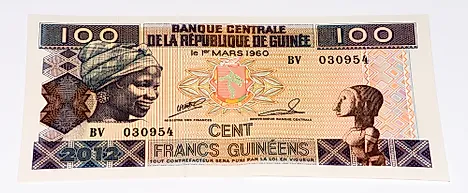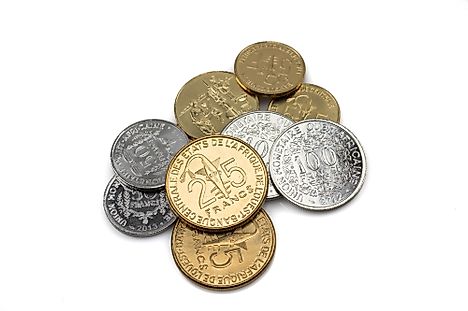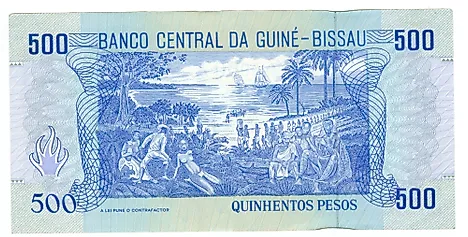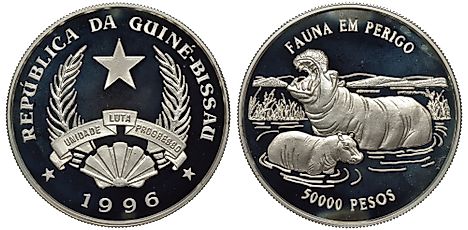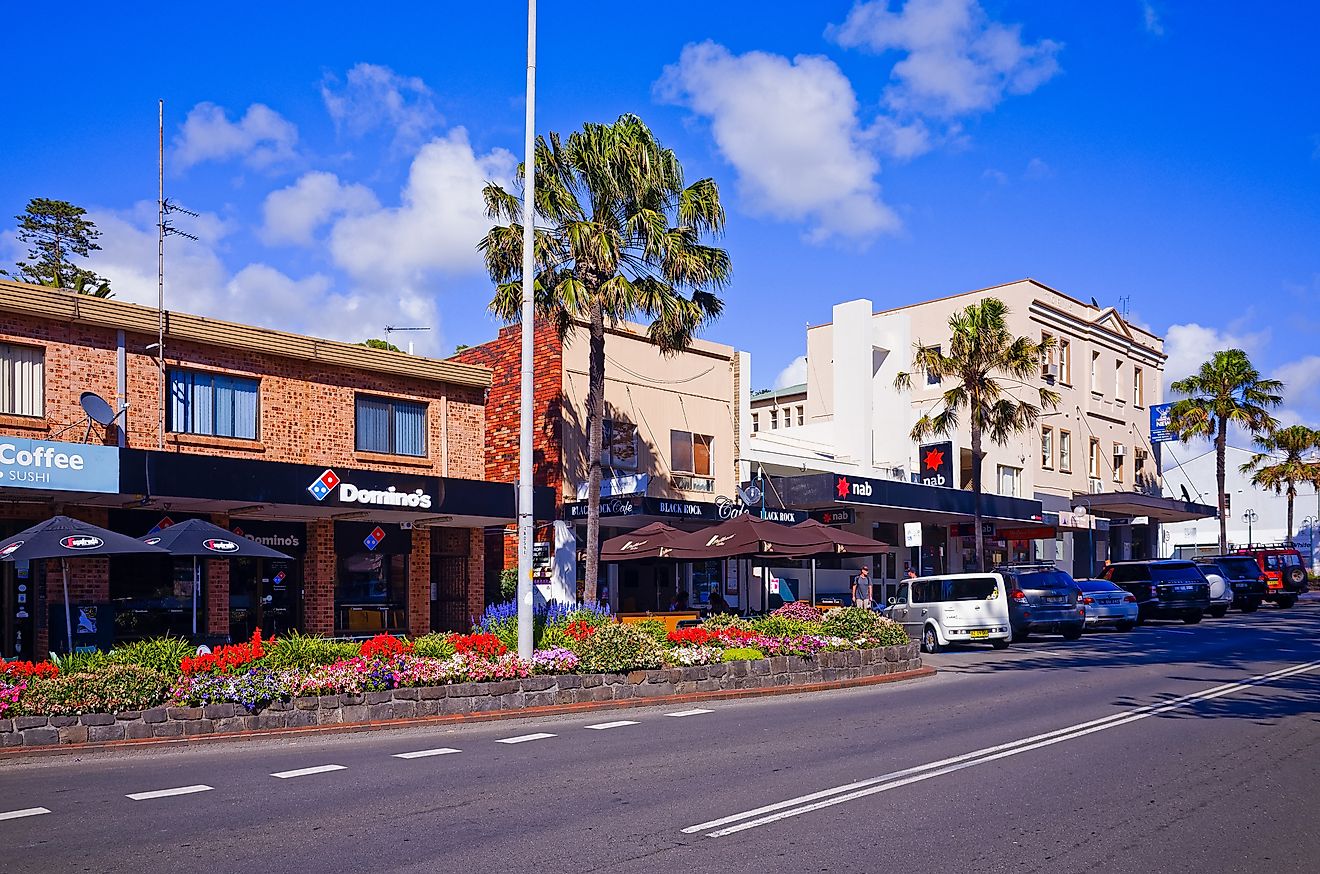Flags, Symbols, & Currencies of Guinea-Bissau
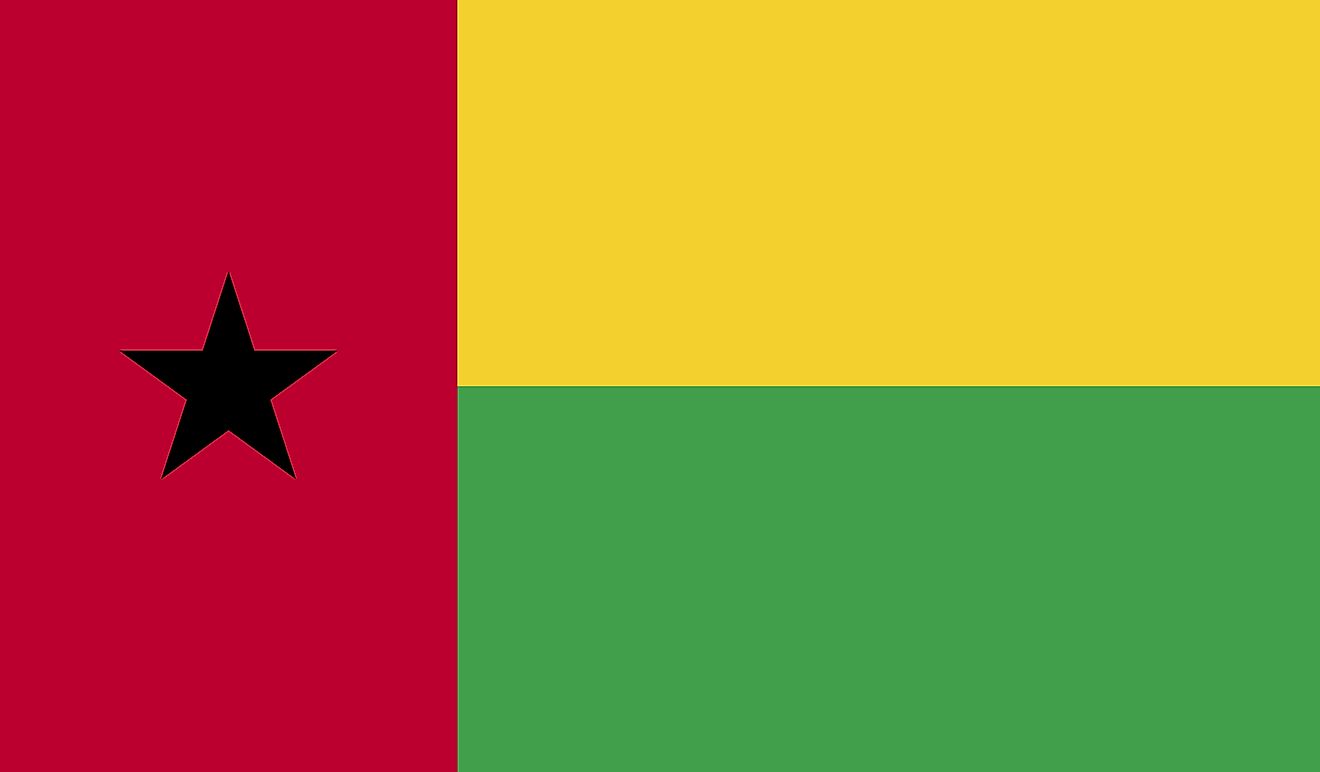
The national flag of Guinea was officially adopted on September 24, 1973, when the country attained independence from Portugal. The flag is based on the flag of the African Party for the Independence of Guinea and Cape Verde (PAIGC) and features two equal horizontal bands of yellow (top) and green with a vertical red band on the hoist side. There is a black five-pointed star centered in the red band. The flag of Guinea-Bissau resembles the Ghanaian flag except that the red band on the flag of Ghana is horizontally design and the black star is placed at the center of the yellow band.
Like the Ghanaina flag, the colors on the Guinea-Bissau's flag are the traditional Pan-African colors of red, golden, and green. Red symbolizes the struggle and blood shed for independence, while yellow symbolizes the mineral wealth and green denotes the natural resource, particularly forest. The black star stands for African unity. The national flag of Guinea-Bissau has a height to length proportion of 1:2.
Symbols of Guinea-Bissau
Coat of Arms of Guinea-Bissau
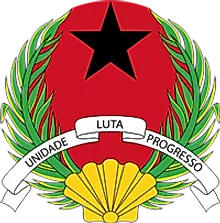
The national coat of arms of Guinea-Bissau closely resembles PAIGC's official symbol. It was adopted alongside the national flag in 1973. Initially, the arms featured a seashell at the bottom uniting two olive branches, a black star at the top, and a red banner with the motto: Unidade, Luta, Progresso (Unity, Struggle, Progress). However, the coat of arms was modified in 1994 and now consists of a black star against a red background, with the seashell uniting the two olive branches. The red banner was replaced with a white banner but the motto on the banner was retained. The seashell is a symbol of the country's location (West coast of Africa). The black star is a symbol of Pan-Africanism, while red is the color of struggle for independence.
National Anthem
- Anthem Title: Esta É a Nossa Pátria Bem Amada (This Is Our Well Beloved Fatherland)
- Music composer: Xiao He
- Lyricist: Amilcar Cabral
- Date of Adoption: 1974
"Esta É a Nossa Pátria Bem Amada" is the national anthem of Guinea-Bissau, officially adopted at independence in 1974. It also served as Cape Verde's national anthem until 1996, when the country chose a different anthem.The anthem's lyrics were written by Amilcar Cabral, a pan-Africanist and anti-colonial leader who died before the country's independence. However, Xiao He is credited with the composition of the music.
Esta É a Nossa Pátria Bem Amada (Portuguese)
Sol, suor e o verde e mar,
Séculos de dor e esperança;
Esta é a terra dos nossos avós!
Fruto das nossas mãos,
Da flôr do nosso sangue:
Esta é a nossa pátria amada.
Coro:
Viva a pátria gloriosa!
Floriu nos céus a bandeira da luta.
Avante, contra o jugo estrangeiro!
Nós vamos construir
Na pátria imortal
A paz e o progresso!
Nós vamos construir
Na pátria imortal
A paz e o progresso!
Ramos do mesmo tronco,
Olhos na mesma luz:
Esta é a força da nossa união!
Cantem o mar e a terra
A madrugada e o sol
Que a nossa luta fecundou.
Coro
This Is Our Well Beloved Fatherland
Sun, sweat, verdure, and sea,
Centuries of pain and hope;
This is the land of our ancestors.
Fruit of our hands,
Of the flower of our blood:
This is our beloved motherland.
Chorus:
Long live our glorious country!
The banner of our struggle
Has fluttered in the skies.
Forward, against the foreign yoke!
We are going to build
Peace and progress
In our immortal country!
Peace and progress
In our immortal country!
Branches of the same trunk,
Eyes in the same light;
This is the force of our unity!
Sing the sea and the land,
The dawn and the sun
That our struggle has borne fruit!
Chorus
The Currency of Guinea-Bissau is the CFA franc
Guinea-Bissau is a country located on the West African Atlantic coast. It is among the eight countries that form the African Financial Community that was introduced by the French. The French believed that globalization would steer its wheels to these African nations and the only way to embrace it was through a community. In 1997, Guinea-Bissau joined the financial community and had to change its currency from the Guinea-Bissau peso to the West African CFA franc, which is the currency used many countries in West Africa. The currency is coded as XOF in the ISO 4217 currency code and is issued by the Central Bank of West African States headquartered in Senegal.
History of CFA Franc
The CFA franc was established in 1945 in the wake of the Bretton Wood conference as a means of cushioning from the strong devaluation of the franc. In 1958, the CFA became the franc of "French Community in Africa" after Général de Gaulle incorporated the concept of a community to all French colonies of West and Central Africa. In 1994, the CFA franc was devalued by 50% to stimulate economic growth in the region in terms of increasing imports. With the launch of the UMEAO, an economic union of the West African nation, internal tariffs have been reduced to promote trade in West Africa.
Coins
The first CFA franc coins were introduced in 1948 as aluminum coins in denominations of 1 and 2 franc. Bronze coins in denominations of 5, 10 and 20 franc were introduced in 1957, all bearing the name Afrique Occidentale Français in Togo, and later the minting of coins was transferred to BCEAO which continues to distribute coins up to date. In 1967, 100 nickel and 50 cupro-nickel coins were introduced, followed by bimetallic 200 and 500 franc coins in 2003 that are still used to date as legal tender in Guinea-Bissau.
Banknotes
The franc was first introduced in 1946 in several denominations including 5, 10, 25, 50, 100, and 1,000 francs. When Guinea-Bissau took over the issuance of the currency, the minimum denomination of the banknote was 50 franc. In 2003, the 500 franc banknote was replaced with a coin due to the devaluation of the currency. In 2004, other denominations of 1,000, 2,000, 5,000, and 10,000 francs were issued with the new notes signifying the rich heritage of West Africa. The 500 franc denoted the advancement in technology, the 1,000 franc was a symbol of education and health, the 2,000 franc symbolized rich network in transportation, the 5,000 franc denoted the rich agricultural field, and the 10,000 franc symbolized telecommunication networks.
Historical Currencies of Guinea-Bissau
The Guinea-Bissau peso was a major currency in circulation in Guinea-Bissau from 1975 to 1997, having replaced the Portuguese Guinean escudo. It was minted in the form of coins and banknotes, with the coins being in denominations of 1, 2½, 5 and 20 pesos and 50 centavos, while banknotes in denominations of 50, 100, and 500 pesos were printed in 1975, followed by 1,000 peso notes in 1978, and 10,000 peso notes in 1990. The peso continued to be used in Guinea-Bissau until it was phased out at the rate of 65 Guinea-Bissau pesos for 1 CFA franc.
